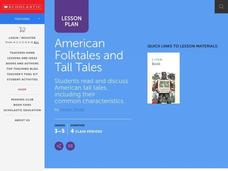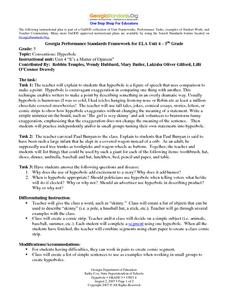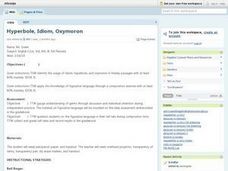Curated OER
Tell a Ton of Tall Tales
Elementary schoolers read many tall tales. They create their own tall tale about a specific event of their choosing. They must act the part of the author. This well-designed lesson takes three class sessions to complete, and is...
Curated OER
"Knot" the Whole Truth: Writing a Modern-Day Story with a Tall Tale's Voice
Beyond Paul Bunyan and his blue ox, tall tales can be a great way to teach young writers about word choice and voice in their writing. Using Jerry Spinelli's Maniac Magee and the Six-Trait Writing process, they begin to write their own...
Curated OER
Exaggeration
Students read the tall tale of Pecos Bill and identify an exaggeration in the story which they state as being part of a tall tale. In this exaggeration lesson plan, students identify the exaggeration by drawing a picture.
Curated OER
Tall Tales Today
Students explore the attributes of American tall tales. In this folklore lesson, students read several tall tales, describe the elements of tall tales, and then use hyperbole to write their own tall tales.
Curated OER
Tabloid Tales
Students write news stories to accompany tabloid headlines. In this tabloid lesson plan, students learn the power of persuasion and exaggeration by writing stories based on actual tabloid headlines.
Curated OER
Men of Steel
Learners explore early 20th century steel making. In this U.S. history steel making lesson, students view and describe a postcard and a picture depicting exaggerated aspects of the steel industry. Learners listen to a poem about Joe...
Curated OER
American Folktales and Tall Tales
Middle schoolers explore the elements of American folktales. They discuss how they are passed on from generation to generation, how they use exaggeration, and how they convey a message or make a point. Students identify common elements...
Curated OER
Conventions: Hyperbole
Fifth graders discuss hyperbole. In this language arts lesson plan, 5th graders understand that hyperbole enables writers to make a point by describing something in an overly dramatic way. Students create a list of objects that can be...
K20 LEARN
Here's How I Heard It: Using Folklore To Improve Close Reading Skills
"X" is for exaggeration, and "F" is for fact. To encourage close reading and to improve literary analysis skills, class members annotate fables and tall tales, like Paul Bunyan, with symbols that identify key features of this genre.
K20 LEARN
Criminal Motivations: Irony and Characterization In "The Cask Of Amontillado"
Edgar Allan Poe's short story "The Cask of Amontillado" is a bit of a puzzle. Critics have long debated Montresor's motives for killing Fortunato. Young scholars examine examples of the three types of irony (verbal, dramatic, and...
Curated OER
The Notorious Hope Diamond: What Makes an American Legend?
Students view and discuss a video on the legend of the Hope Diamond then compare and contrast other tales such as Paul Bunyan, Pecos Bill and Johnny Appleseed. They analyze basic characteristics of these legends then use descriptive...
Curated OER
Hyperbole, Idiom, Oxymoron
Fourth graders identify the usage of idiom, hyperbole, and oxymoron in literary passages. They apply this knowledge of figurative language through a composition exercise. The writing of teacher generated examples is also helpful.
Curated OER
Knights of the Round Table adapted by Gwen Ross
Everyone loves the tales involving King Arthur and his knights. After reading Knights of the Round Table by Gwen Gross, learners draw inferences and conclusions, analyze story elements, and discuss figurative language, including...
Curated OER
Tell Me a Whopper!
Sixth graders investigate tall tales as a literary genre. They listen to a number of tall tales to discover how exaggeration is used as a story element. They write and publish a tall tale using word processing software. They illustrate...
Curated OER
How I Spent My Summer Vacation
Learners hear the story How I Spent My Summer Vacation by Wallace Bleef and share their own summer experiences. They write a tale about one event that happened during their summer using exaggeration.
Curated OER
The Stinky Cheese Man and Other Fairly Stupid Tales
Sixth graders demonstrate the ability to process and evaluate content from a variety of sources and apply comprehension skills to the material read. They organize information for practical use and design and develop an informational...
Curated OER
Art Lesson: Doll Making
Students read and discuss the main characters and supporting characters in the African folktale, "Tiger and the Big Wind." They highlight the physical features of the animal that makes them unique and transfers those same qualities to...
Curated OER
Helping Others
Students explore philanthropy. In this service learning lesson, students read The Seven Chinese Brothers, identify the elements of the story, and then go out in the world to help others by sharing their talents.
Curated OER
Good Will - Three Chinese Stories
Young scholars listen to The Seven Chinese Brothers and identify tall tale elements in it. They brainstorm ways they could help each other in school. They create a banner reflecting the style and art of Chinese decorations and clothing...




















